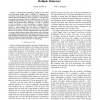Free Online Productivity Tools
i2Speak
i2Symbol
i2OCR
iTex2Img
iWeb2Print
iWeb2Shot
i2Type
iPdf2Split
iPdf2Merge
i2Bopomofo
i2Arabic
i2Style
i2Image
i2PDF
iLatex2Rtf
Sci2ools
CEC
2009
IEEE
2009
IEEE
How robot morphology and training order affect the learning of multiple behaviors
— Automatically synthesizing behaviors for robots with articulated bodies poses a number of challenges beyond those encountered when generating behaviors for simpler agents. One such challenge is how to optimize a controller that can orchestrate dynamic motion of different parts of the body at different times. This paper presents an incremental shaping method that addresses this challenge: it trains a controller to both coordinate a robot’s leg motions to achieve directed locomotion toward an object, and then coordinate gripper motion to achieve lifting once the object is reached. It is shown that success is dependent on the order in which these behaviors are learned, and that despite the fact that one robot can master these behaviors better than another with a different morphology, this learning order is invariant across the two robot morphologies investigated here. This suggests that aspects of the task environment, learning algorithm or the controller dictate learning order more...
| Added | 20 May 2010 |
| Updated | 20 May 2010 |
| Type | Conference |
| Year | 2009 |
| Where | CEC |
| Authors | Joshua S. Auerbach, Josh C. Bongard |
Comments (0)

